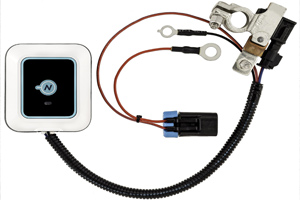Nautic-On Boat Monitoring System

It is strange that in this day and age, when we can remotely manage our homes, cars, bank accounts, TVs, children, pets, and toasters, that boat monitoring systems seem behind the trend. Some owners are separated from their boats for weeks or months at a time and depend on a boat sitter to drop in occasionally to check out the bilge or, unfortunately, ward off potential break-ins. With worst-case scenarios including ship sinkings, fires, storm damage, and more, keeping an eye on that boat is vital.
Enter the Nautic-On boat monitoring system, a new product line under Brunswick. Nautic-On is the first move from Brunswick, owner of Sea Ray and Boston Whaler brands to name a few, to launch their own monitoring system. While new, Nautic-On hopes to compete with other tried-and-true systems with an emphasis on precision and detailed reports on the monitored components. For example, the average monitoring system can tell you when your battery is low using two wires that measure voltage. Nautic-On claims their sensors will be able to monitor voltage, plus battery temperature and bi-directional current flow. Other brands’ sensors attach to bilge pumps using a wire to tell you how many times and for how long the bilge pump was activated; Nautic-On sends alerts regarding pumping and cavitation—if the pump has been activated manually or by float switch, and if the pump is clogged. The engine sensors connect via any Mercury SmartCraft or NMEA 2000 compliant system, sending fault codes from the engine and alerting you to any issue. You can receive data on rpm, oil and water pressure, and engine temperature from home or while underway.
The sensors attach to the power sources of the components they’re monitoring, giving them an estimated ten-year life span without a battery change. The hub and the sensors communicate wirelessly and can be installed anywhere convenient from the cabin to the engine room. The simplicity of the system makes it ideal for do-it-yourselfers. The data collected by the main hub is sent to your phone and displayed in the Nautic-On app.

Nautic-On is courting both private boat owners and industry professionals by emphasizing ease of communication between the two. If permission is granted, information that is available to a boat owner can be shared seamlessly with a dealer or service provider. Technicians with the required experience and breadth of knowledge to work on boats are becoming harder and harder to find, and during the summer season, they can be booked as many as three weeks out, an eternity as the good weather goes to waste. The data collected from Nautic-On’s sensors greatly reduces the amount of time it takes for a technician to diagnose an issue, speeding up completion of a job for the boat owner and minimizing non-billable hours for service yards. Brunswick is hoping that if their new boat monitoring system proves robust and useful, they can be built directly into new boats.
While the sensors from Nautic-On provide extremely detailed data on some aspects of your boat, it lacks information on others entirely. Contact switches, shore power input, bilge high water, and stand-alone temperature are some of the variables that the system doesn’t monitor. The company has made it clear they intend to perfect sensors specific to those areas before they are offered. Besides the battery, pump, and engine sensors mentioned, the current Nautic-On system uses GPS to track boat location, alerting you to any surprise movement, and updating you on weather conditions wherever your boat is stored.
If you think your boat deserves to have a closer eye kept on it, and you want to try a product from a manufacturer with a reputation like Brunswick’s, visit nautic-on.com. The sensors and hub are sold in different packages, from just one sensor with hub at $600 to the eight-sensor with hub package for $1,500.